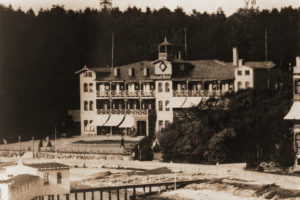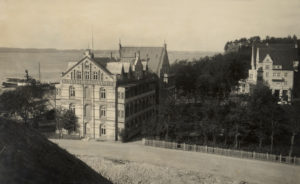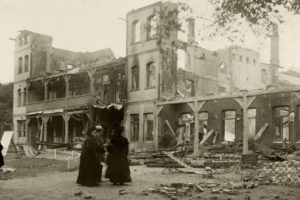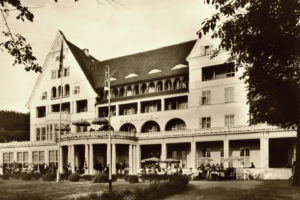The “Strandhotel Glücksburg” was built in 1872 in the heyday of spa architecture – and high society guests were soon staying there.
The beginning
Dr Christian Schmid, a doctor in Glücksburg since 1871, became aware of several articles written by Dr Mesinga, a colleague in Flensburg. In these articles the latter extolled the beach and the beauty of the surroundings of Sandwig Bay. Contact was made and the “Aktiengesellschaft des Ostseebades Glücksburg” was established. A further 80 shareholders were soon found for this company. The Baltic resort company quickly decided to build a hotel at Sandwig beach and called it “Curhaus”. As a result of a storm surge in November 1872 so much sand had been driven into Sandwig Bay that a natural beach with fine sand was created. Duke Charles laid the foundation stone on 8 May 1872. The official opening took place 55 days later.
The “Curhaus” had six guest rooms which were intended primarily for older guests. Many large parties were organised, which were at first held in a tent. It was recognised at the end of 1872 already that expansion of the hotel was inevitable. The extended building was opened on 12 July 1873 under the name of “Strandhotel”. The hotel now had two floors, 27 rooms with a balcony, a hall, a bathhouse and 28 bathing carts. Only two years later, in 1875, the hotel was enlarged again. The hotel now had 70 rooms, several salons and a ballroom.
At that time, about 350 guests stayed the night in the summer. The season only comprised the summer months, but the guests remained for several weeks in some cases. They arrived primarily by steamer. The temporary jetty, which was located directly in front of the hotel, was converted into a permanent pier. One of the first ships to dock was the “Seeadler”.
There was an onrush of guests to the hotel due to this development. Towards the end of the 19th century it became a central arrival point in Glücksburg. By ship, by train and later by car people from all over the world as well as from Flensburg arrived at the weekends. Improved transport links were responsible for this development.





